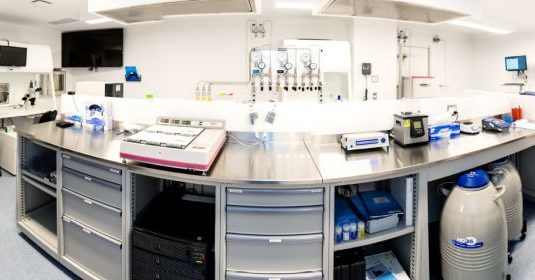
Ask the doctor: What’s so special about egg vitrification?
You asked: I’ve heard of egg vitrification, but what’s the big deal? How is it superior to other types of egg freezing?
Dr. Maslow answers:
Great question. It’s a little-known fact that the lab—and the technology at use inside the lab—is as important as the doctor when it comes to egg freezing success. Egg vitrification is kind of a big deal, because it’s one of the advances that has allowed us to offer effective egg freezing to more women.
How egg vitrification works
First, a little background. Egg cryopreservation (freezing) requires that egg cells reach, and remain, at -196º Celsius (or about -320º Fahrenheit). That’s the temperature at which all biological processes inside the cell cease, and it can be safely stored.
Contact Us to Chat with a Fertility Advisor
Prior to the development of egg vitrification, cryopreservation was done with a method known as slow freezing (or “controlled rate” freezing). During slow freezing, the egg cell is cooled very slowly—at a decrease of .3º–2º Celsius per minute—until it reaches -196º Celsius. This is done inside a controlled rate freezer filled with liquid nitrogen to allow it to reach very low temperatures.
The problem with slow freezing is that the longer the egg freezing process takes, the more likely it is that ice crystals will form in the egg cell. Ice crystals, which form within the water in a cell, can cause damage to cell structures and make it impossible for the egg to survive and fertilize. This is especially crucial for eggs, which have a higher water content than other cells you might freeze (like sperm).
The vitrification method of egg freezing addresses this key problem. Egg vitrification is a “flash freezing” method in which cells are immersed directly into liquid nitrogen, cooling them so quickly to -196ºC that they become “glass-like” or “vitrified.” While the slow freezing technique takes hours, vitrification is completed nearly instantly, significantly reducing the chance that ice crystals will form and damage the cell.
As a result, egg vitrification success rates—defined by the percentage of eggs that survive being thawed—are significantly higher than success rates for slow freezing. One study found that vitrified eggs have an over 83% freeze-thaw survival rate (compared to the approximately 66% survival rate of eggs after slow freezing). Another found an even starker difference—in that study, slow frozen eggs had a survival rate of just 61%, while eggs frozen with vitrification had a survival rate of 91%.
Other than what happens inside the lab, egg vitrification doesn’t alter the egg freezing process in any way. The same medications are used with the same protocols, and the cost of egg vitrification is no different than the cost of slow freezing. There’s also no difference in storage capabilities—both slow frozen eggs and vitrified eggs can be stored at -196ºC indefinitely without any loss of viability. All in all, it’s a big win, and it was due to the success of vitrification that egg freezing graduated from experimental treatment to real option for women who want to preserve their fertility: In 2013, after many studies demonstrated that egg vitrification was safe and effective, the ASRM decided to remove the label of “experimental” for egg freezing.
Learn more about vitrification vs. slow freezing.
Vitrification isn’t the only variable
Even with the advent of egg vitrification, the superiority of the laboratory using the technique will dramatically impact results. In our lab at Extend and Expect Fertility, we use the Cryotec method of egg vitrification, an advanced set of protocols developed by renowned embryologist Dr. Masashige Kuwayama, that is designed to produce egg survival rates near 100%.
Other factors within the lab that can affect the success of egg vitrification include:
- Pre-cryopreservation conditions. In our lab, we use temperature-controlled surfaces to maintain eggs at a normal body temperature of 37º Celsius until they are frozen.
- Air quality. Our laboratory was specially designed with state-of-the-art filters, air locks, and an air-handling system that uniquely isolates the lab environment from the rest of the floor. These precautions reduce the level of volatile organic compounds (VOCs), particulate, and microbial contaminants to the lowest possible level to produce the safest possible environment for egg freezing. Our lab is designated a “Class 1000” laboratory, meaning that, on average, the air contains no more than 1,000 particles per every cubic foot. (For comparison, the typical office building contains anywhere from 500,000 to 1,000,000 particles per cubic foot of air.)
- Incubators. We use benchtop incubators instead of the older box incubator style that contains many patients’ eggs in one chamber. In the case of a box incubator, every time the incubator is opened to access a patient’s eggs, the environment inside changes—and because box incubators are larger, it takes longer for their interiors to return to the optimal temperature and pH. The six small chambers of the benchtop incubator each contain only one patient’s eggs, allowing precise control and stability of the incubator environment.
Many older practices don’t have labs with these new features, and we’re proud to bring completely cutting edge technology to the world of egg freezing. Learn more about how the lab you choose can affect your egg freezing success.
When considering egg freezing, ensure the practices you’re considering are using the best possible technology
At this point, we know enough to say that egg vitrification should be the bare minimum of lab excellence—every lab that freezes eggs should be using this technique, and should be able to give you an idea of how the design, environment, and equipment used in their lab ensures optimal freezing conditions and survival rates for your eggs.
Want to learn more about egg freezing at Extend Fertility? Contact us.




